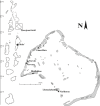Compartmentalized organization of ecological niche occupation in insular invertebrate communities
- PMID: 33437443
- PMCID: PMC7790627
- DOI: 10.1002/ece3.7067
Compartmentalized organization of ecological niche occupation in insular invertebrate communities
Abstract
Understanding the mechanisms of species distribution within ecosystems is a fundamental question of ecological research. The current worldwide changes and loss of habitats associated with a decline in species richness render this topic a key element for developing mitigation strategies. Ecological niche theory is a widely accepted concept to describe species distribution along environmental gradients where each taxon occupies its own distinct set of environmental parameters, that is, its niche. Niche occupation has been described in empirical studies for different closely related taxa, like ant, ungulate, or skink species, just to name a few. However, how species assemblages of whole ecosystems across multiple taxa are structured and organized has not been investigated thoroughly, although considering all taxa of a community would be essential when analyzing realized niches. Here, we investigated the organization of niche occupation and species distribution for the whole ground-associated invertebrate community of small tropical insular ecosystems. By correlating environmental conditions with species occurrences using partial canonical correspondence analysis (pCCA), we demonstrated that the ground-associated invertebrate community does not spread evenly across the overall niche space, but instead is compartmentalized in four distinct clusters: crustacean and gastropod taxa occurred in one cluster, attributable to the beach habitat, whereas hexapods and spider taxa occurred in three distinct inland clusters, attributable to distinct inland habitats, that is, grassland, open forest, and dense forest. Within the clusters, co-occurrence pattern analysis suggested only a few negative interactions between the different taxa. By studying ground-associated insular invertebrate communities, we have shown that species distribution and niche occupation can be, similar to food webs, organized in a compartmentalized way. The compartmentalization of the niche space might thereby be a mechanism to increase ecosystem resilience, as disturbances cascade more slowly throughout the ecosystem.
Keywords: Niche clustering; ecological community; habitat; insular ecosystem; modularity; niche segregation; species assemblage.
© 2020 The Authors. Ecology and Evolution published by John Wiley & Sons Ltd.
Conflict of interest statement
The authors declare no conflicting interests.
Figures




Similar articles
-
Aquatic food web expansion and trophic redundancy along the Rocky Mountain-Great Plains ecotone.Ecology. 2023 Jul;104(7):e4103. doi: 10.1002/ecy.4103. Epub 2023 May 30. Ecology. 2023. PMID: 37203414
-
Functional response traits and altered ecological niches drive the disassembly of cloud forest bird communities in tropical montane countrysides.J Anim Ecol. 2022 Nov;91(11):2314-2328. doi: 10.1111/1365-2656.13816. Epub 2022 Oct 2. J Anim Ecol. 2022. PMID: 36161275
-
Multiple stressors shape invertebrate assemblages and reduce their trophic niche: A case study in a regulated stream.Sci Total Environ. 2021 Jun 15;773:145061. doi: 10.1016/j.scitotenv.2021.145061. Epub 2021 Feb 4. Sci Total Environ. 2021. PMID: 33940713
-
Vertical stratification patterns of tropical forest vertebrates: a meta-analysis.Biol Rev Camb Philos Soc. 2023 Feb;98(1):99-114. doi: 10.1111/brv.12896. Epub 2022 Sep 8. Biol Rev Camb Philos Soc. 2023. PMID: 36073113 Review.
-
[Maintaining mechanisms of riparian invertebrate biodiversity: A review].Ying Yong Sheng Tai Xue Bao. 2020 Mar;31(3):1043-1054. doi: 10.13287/j.1001-9332.202003.032. Ying Yong Sheng Tai Xue Bao. 2020. PMID: 32538002 Review. Chinese.
Cited by
-
Allochthonous resources are less important for faunal communities on highly productive, small tropical islands.Ecol Evol. 2021 Aug 26;11(19):13128-13138. doi: 10.1002/ece3.8035. eCollection 2021 Oct. Ecol Evol. 2021. PMID: 34646457 Free PMC article.
-
Tourism and urban development as drivers for invertebrate diversity loss on tropical islands.R Soc Open Sci. 2021 Oct 13;8(10):210411. doi: 10.1098/rsos.210411. eCollection 2021 Oct. R Soc Open Sci. 2021. PMID: 34659777 Free PMC article.
References
-
- Anderson, M. J. (2001). A new method for non‐parametric multivariate analysis of variance. Austral Ecology, 26, 32–46.
-
- Bliss, D. E. , & Mantel, L. H. (1968). Adaptations of crustaceans to land: A summary and analysis of new findings. American Zoologist, 8, 673–685. 10.1093/icb/8.3.673 - DOI
-
- Broennimann, O. , Fitzpatrick, M. C. , Pearman, P. B. , Petitpierre, B. , Pellissier, L. , Yoccoz, N. G. , Thuiller, W. , Fortin, M.‐J. , Randin, C. , Zimmermann, N. E. , Graham, C. H. , & Guisan, A. (2012). Measuring ecological niche overlap from occurrence and spatial environmental data. Global Ecology and Biogeography, 21, 481–497. 10.1111/j.1466-8238.2011.00698.x - DOI
-
- Burggren, W. W. , & McMahon, B. R. (1988). Biology of the land crabs. Page (Burggren W. W., & McMahon B. R., Eds.). Cambridge University Press.
Associated data
LinkOut - more resources
Full Text Sources
Other Literature Sources

